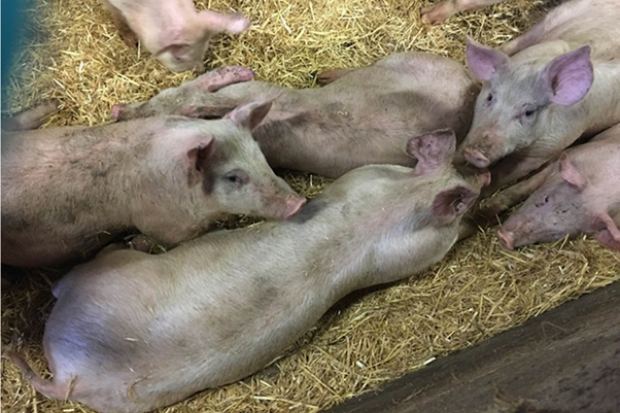
In 2023, The Department for Environment, Food and Rural Affairs (Defra) launched the Animal Health and Welfare Pathway Animal Health and Welfare Pathway - GOV.UK. The pathway supports improving farm animal health and welfare and works in partnership with farmers, vets, the wider industry and the supply chain. One of its aims is to improve biosecurity to control diseases already present in the United Kingdom (UK) and help prevent the introduction of new threats.
Spotlight on Porcine Reproductive and Respiratory Syndrome
One of the diseases highlighted in the pathway is Porcine Reproductive and Respiratory Syndrome (PRRS), which costs the farming industry an estimated £52 million per year. This cost includes direct losses, for example: piglet deaths and slower growth (weight gain) in infected pigs, and indirect such as increased antibiotic use to treat additional infections, linking PRRS to the problem of antimicrobial resistance (AMR).
PRRS was first detected in the UK and other regions in the early 1990s. Today, the virus has spread globally and is present in pig populations around the world. PRRS can cause a wide range of clinical signs including respiratory problems in young piglets and reproductive issues for female pigs (sows). The disease affects pigs of all ages, so can have a huge impact.

Like many other viruses, PRRSV genes often change (mutate) so the virus is constantly evolving. It is a very generous virus, happily sharing its genetic material with other PRRS viruses when it gets the chance by using a process called recombination. This means that the virus can quickly change, which can result in more severe disease or ineffective control using available vaccines.
As the National Reference Laboratory (NRL) for PRRS, APHA is supporting the pathway and national ambition by providing testing and advice and also conducting research to better understand how the virus behaves and what we could do to stop it.
Collaboration is key
As PRRS has such a wide impact, it is important to work together with other organisations and share expertise.
APHA has strong links with other organisations in the UK including Scotland’s Rural College (SRUC), and Northern Ireland's Department of Agriculture and Rural Development (DARDNI). Surveillance and testing expertise is shared with SRUC and DARDNI, including confirmatory testing for some samples, which strengthens our activities across the UK.
The NRL also share data with the national Pig Expert Group and via the quarterly Great Britain pig disease surveillance and emerging threats reports, where any changes in disease patterns are carefully monitored.
As well governmental bodies, the team work with multiple national and international partners to better understand the PRRS virus. Examples include:
- Providing support to investigate PRRS disease outbreaks in Nepal;
- Working with vaccine companies to develop new vaccines to help control PRRS and to reduce the financial and welfare cost of the disease for farmers;
- Working with commercial companies to try out new diagnostic tests;
- Working with pig feed manufacturers to test novel formulations which aim to reduce PRRSV transmission.
Building resilience and future capacity

“APHA’s Virology Department and Surveillance Intelligence Unit have been supporting work on PRRS disease control since the early 1990s. This includes checking that current diagnostic tests are fit for purpose, developing new tests, as well as surveillance activities to see which PRRS viruses are circulating around the UK.
I joined the Virology Department in 2001 and began working with PRRS in 2005. Since then, I have enjoyed working with many colleagues both within APHA and from other groups across the world, with the common aim of tackling this disease. It has been a challenge to keep up with new technologies that can be applied to the work. I have also enjoyed the opportunities for development, such as becoming a better team leader and learning about the role of disease consultant”.
Dr Jean-Pierre Frossard
NRL Head for PRRS, APHA
APHA supports the professional development of our scientific staff by funding academic qualifications. Let us hear from two students in Jean-Pierre’s group who are currently carrying our PhD projects relating to PRRS:
“I began working on PRRS in 2018, mainly tracking PRRS virus from different farms and looking at changes in the virus. That piqued my interest in PRRS, leading me to start a PhD focused on the behaviour of PRRS virus in the field and how the virus changes over time. One of my first tasks is to be able to “see” the virus through fluorescent imaging of virus infected cells. I will also be looking closely at how the PRRS virus changes when it infects a pig – for example, does the virus change more in different bodily organs?”
Steph Clive
APHA
“I started my PhD in October 2024, and have been spending time planning and reading about the research conducted at APHA and other institutes on PRRS, trying to understand the impact of different strains on disease and how pigs react to PRRS virus infection. My PhD focuses on investigating any differences in the initial response when pigs are infected with different PRRS viruses. Currently, I am looking at how we can get the purest PRRS virus isolates from field samples. Once the isolates are ready, they can be used for further experiments for example, comparing different strains to see how quickly they can grow and cause disease”.
Bailey Clark
APHA
Looking ahead
All of this work contributes to the ongoing efforts to improve the control of this important disease of pigs in the UK and worldwide.
Further reading
APHA scientists have helped successfully deliver a new vaccine for porcine reproductive and respiratory syndrome virus type 1 (PRRSV-1) in partnership with The Pirbright Institute.

Recent Comments